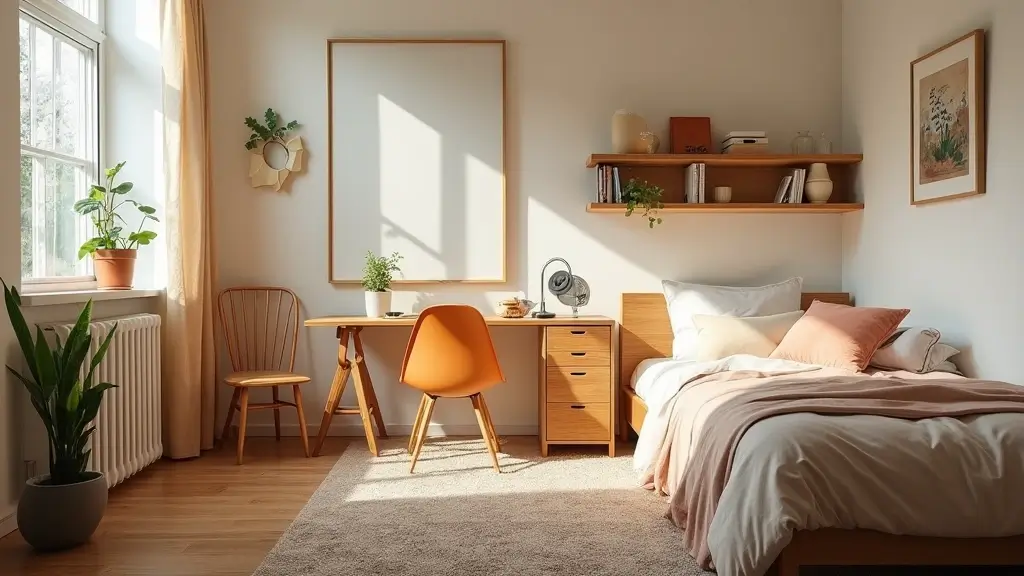Small bedrooms deserve big style. This kind of space can feel cramped and cluttered, even when you own only a few things. I made this post because I want to show you how to get more from a tiny room. You can blend function and style without filling the room with stuff you don’t need. The ideas here are simple, practical, and ready to try.
If you live in a small apartment, a dorm, or a guest room, this is for you. If you care about clean lines, smart storage, and lighting that feels warm, you’ll find something you can use. You’ll see layouts, storage hacks, and decor tricks that fit real spaces and real budgets. It’s not about a perfect showroom look; it’s about a space you can truly live in.
What you’ll get is a curated set of 30 ideas that span storage, layout, lighting, and decor. Each idea comes with quick steps you can implement in a weekend. Think a bed with built in drawers, wall mounted shelves, a fold down desk, or a slim wardrobe that tucks into a corner. These ideas show how to create room for what matters while keeping the room calm and easy to clean.
Here is how to use them. Start with a vibe you love, then pick one or two ideas that fit your space and daily routine. Measure carefully, draw a simple plan, and test changes one by one. You don’t have to redo everything at once. Small shifts add up and can change how you feel in the room.
Being honest about limits helps too. A tiny room will still have limits, so edit ruthlessly. Keep items you actually use and love. Choose multipurpose pieces, like a daybed with storage or a desk that folds away after work. Use light colors and soft textures to make the space feel bigger and friendlier. A mirror or two can bounce light and make the room feel airier.
If you’re ready to turn a cramped bedroom into something cozy and useful, this post is for you. You’ll walk away with practical steps, realistic ideas, and the confidence to try things that fit your style. Let’s make your small bedroom feel like a true retreat that reflects who you are.
1. Lofted Beds for Extra Floor Space
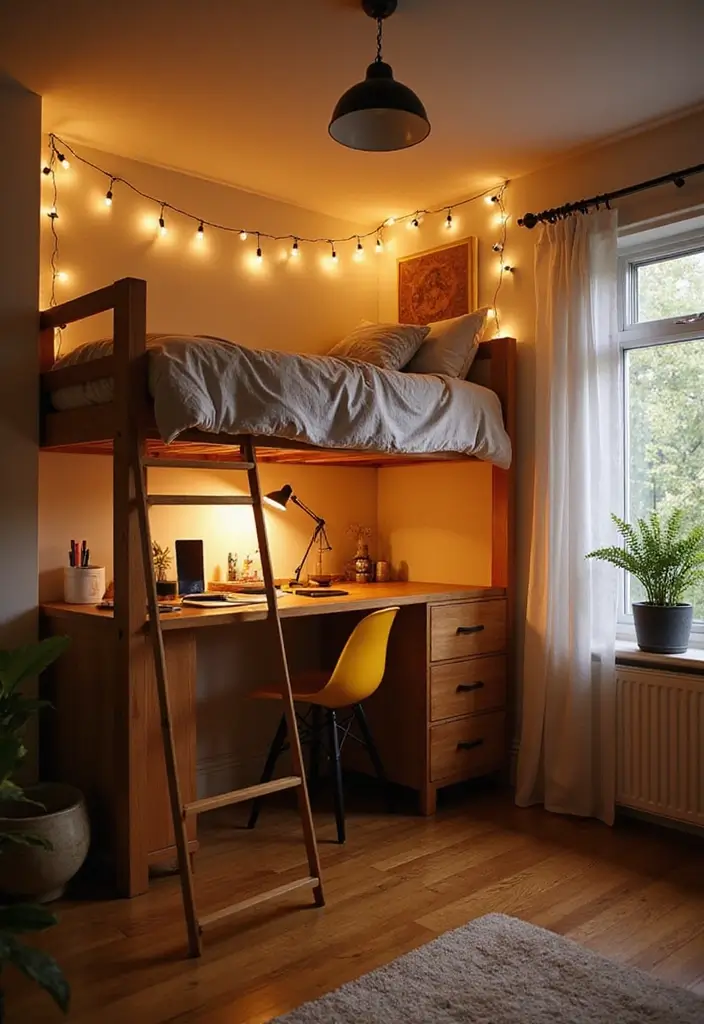
In a small bedroom, you need space for both sleep and daily tasks. Lofted beds lift the sleeping area, giving you valuable floor space for a desk, a chair, or a cozy reading nook. With the bed up high, you turn a single room into a two-zone haven. Below the loft, add storage like slim drawers or baskets to tuck away blankets, books, and chargers.
Here is why this setup works for small rooms.
– Create a compact work corner with a small desk, a chair, and a reading lamp.
– Add low-profile storage under the loft. Bins or drawers keep cords and clothing out of sight.
Pro Tip: Use a ladder that folds away when not in use. This keeps the room feeling open and easy to move around.
– String fairy lights along the edge of the bed or under the loft to add warmth without crowding the space.
– Pick a loft height that leaves comfortable headroom and space to sit at the desk.
– Choose a light frame and pale colors to keep the area feeling roomy.
– Consider a desk with a fold-out surface to save space.
Lofted beds work well in tight rooms because you still sleep well while freeing space for a study area or a lounge spot. That setup is sturdy and easy to install.
2. Customized Built-In Wardrobes
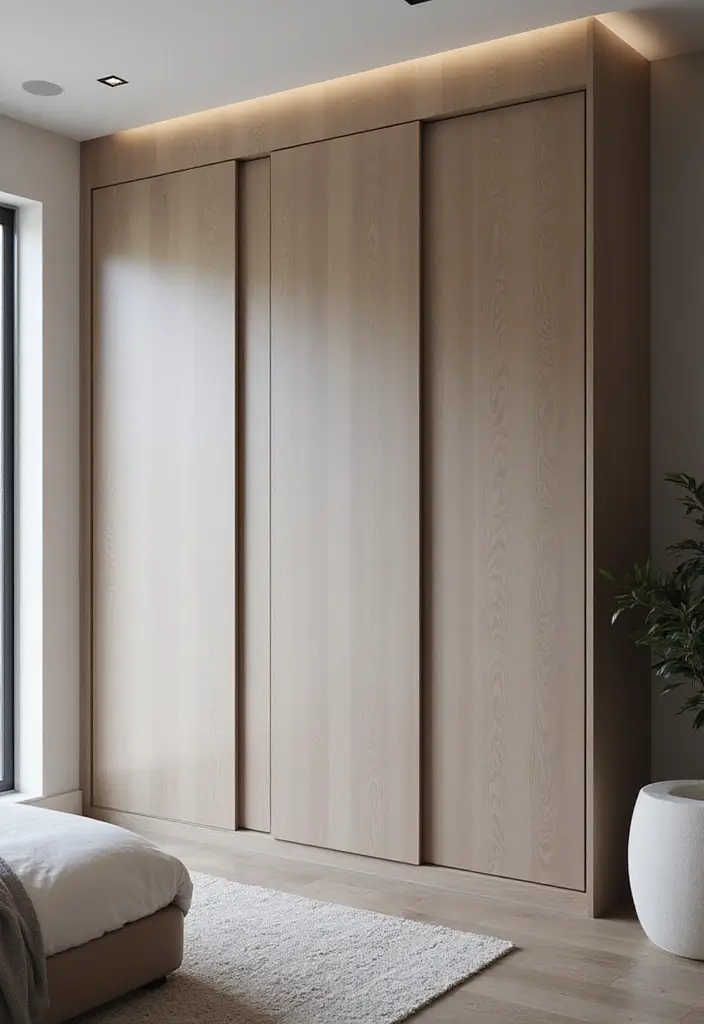
Struggling to store clothes in a small bedroom? A built-in wardrobe can help. It fits your walls and stays out of the way.
Why built-ins work
They run from floor to ceiling and match your space. You get hanging space, shelves, and drawers in exact spots. The room stays calm and feels bigger. A pro designs the layout for your clothes and accessories.
What to plan
– Measure the wall height and width.
– Decide where each area goes: long hanging, shelves, drawers.
– Pick a door style that saves space.
Door options
– Sliding doors don’t swing out, so they save room.
– Mirrored doors brighten the room and make it feel larger.
– Solid panels give a warm, quiet look.
Materials and finish
– Choose durable options that fit your budget.
– Melamine and plywood are common and affordable.
– Real wood adds warmth but costs more.
– Add soft-close drawers to cut noise and wear.
Steps to build
– Sketch a simple plan and share it with a pro.
– See a 3D drawing before you commit.
– Install LED lighting inside for visibility.
– Use baskets for small items.
Tips to stay tidy
– Label boxes and use clear bins. Light interiors help you find items fast.
Space tricks
– If you have a corner, add a shallow corner shelf above hanging space.
– It holds hats and small items and keeps them visible.
Next steps
Scan your wall, then call a wardrobe pro to turn the plan into reality.
3. Multi-Functional Furniture
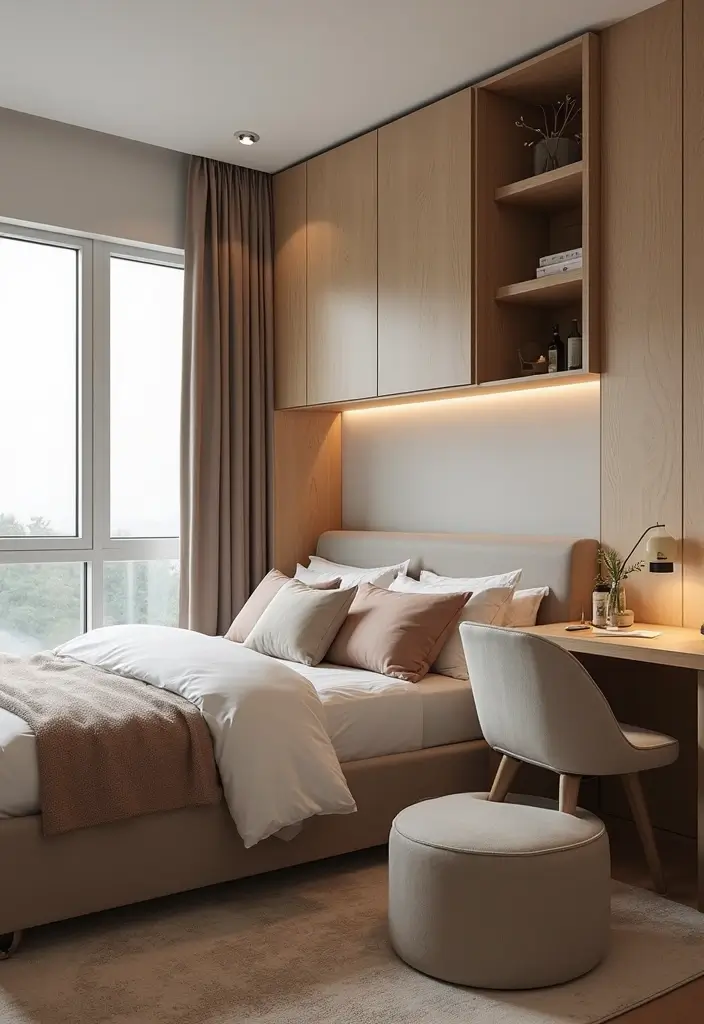
In a small bedroom you need furniture that does more than one job. You want clear surfaces and a way to store things without adding clutter. Multi-functional pieces do just that. They switch roles fast and keep the room calm.
Here is why they matter:
– They tuck away what you own.
– They open space for sleep, work, and play.
– They save you money by replacing several single-use items.
Must-Have Items:
– A bed frame with under-bed storage.
– A foldable desk that can be tucked away when not in use.
When you choose space-saving pieces, check for easy lifting, quiet hardware, and sturdy construction. Look for beds with drawers or a lift mechanism, tables that slide or flip, and ottomans that hide blankets or toys inside.
Next, plan how you move around the room. Put the desk near a window or outlet. Keep heavy items on the floor and light pieces on top. Use color and texture to make the space feel calm, not cramped.
Next steps: measure your space, pick two or three items, and watch for easy setup. With smart choices, you gain function without sacrificing style. Start small and grow as you learn.
4. Vertical Shelving
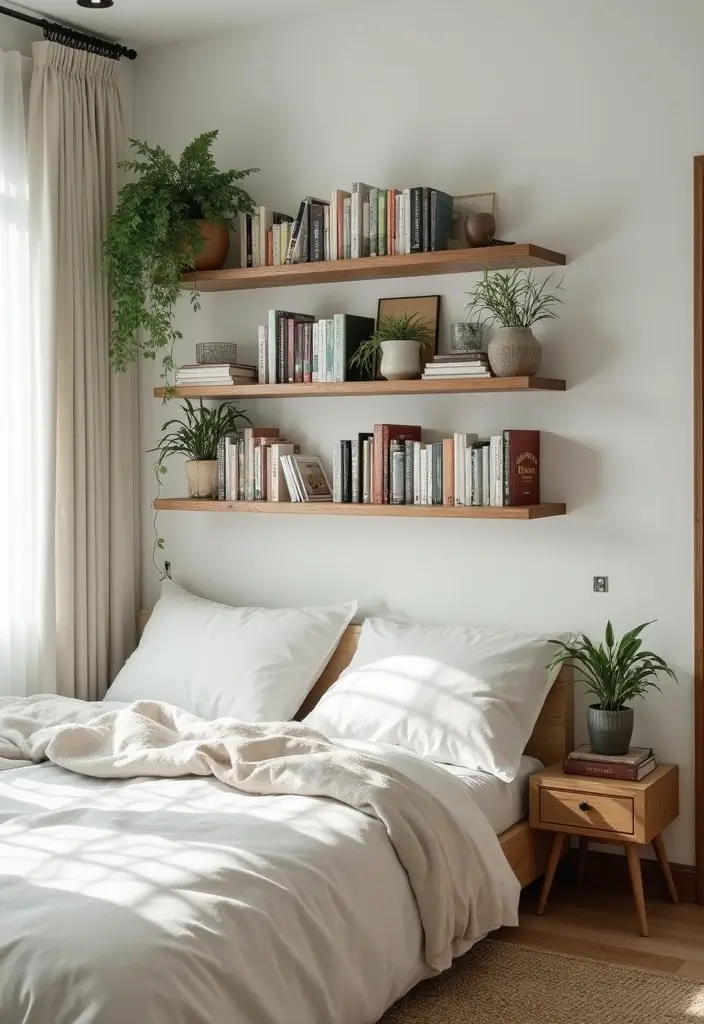
Feeling cramped in a small bedroom? Vertical shelving can unlock wall space and keep the floor open for movement. When you add shelves higher up, you free room for a cozy rug, a slim chair, or a nightstand with room to breathe. The eye naturally climbs, which makes the room feel larger and more airy.
Design Tips:
– Mix shelf sizes for a casual, collected look.
– Place decorative baskets or bins on shelves to hide clutter and add texture.
– Put the tallest shelf near the bed or desk to create a strong vertical spine in the room.
This simple setup brings your personality into view while keeping surfaces clear. You get storage that serves as décor, not just a stash spot.
Next steps to implement:
– Check the wall type and use sturdy anchors so shelves stay in place.
– Measure the wall and plan where each shelf will sit. Start with two or three shelves at varying heights.
– Keep everyday items within easy reach on the lower shelves. Put art, books, or plants higher up for visual interest.
– Use clear or woven baskets to maintain order without heavy lifting every time you search.
With a little planning, vertical shelves become a smart backbone for small rooms. They hold what you need and still feel light, open, and welcoming.
5. Clever Under-Bed Storage
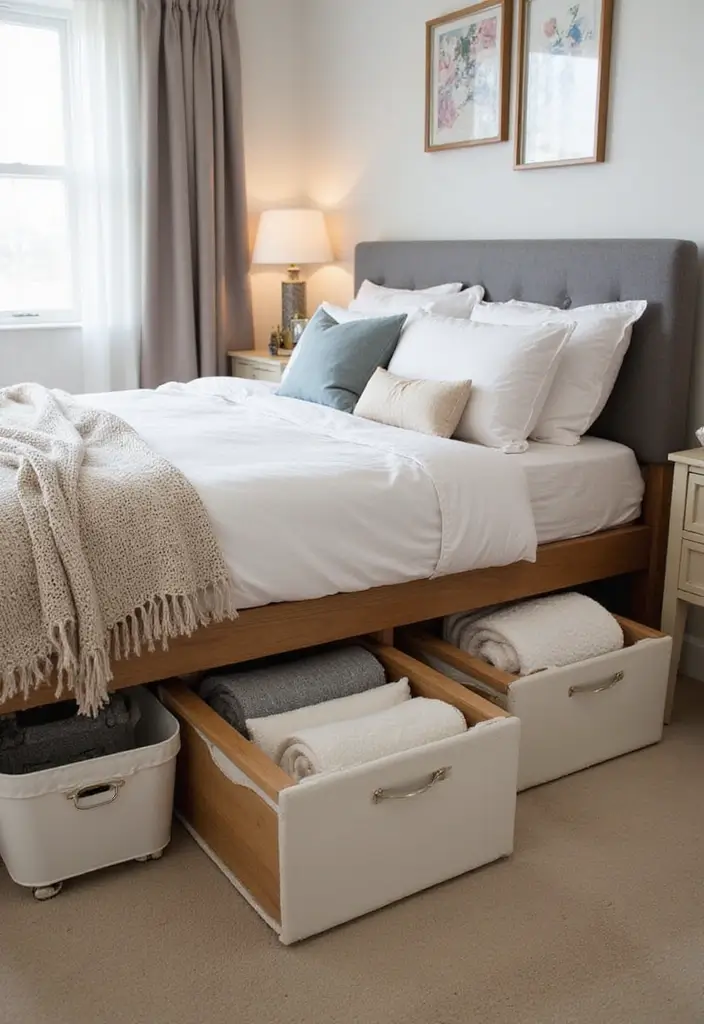
Your bed hides a handy space. It can hold seasonal clothes, extra sheets, or comfy shoes without crowding your room. Don’t let clutter creep in. A calm bedroom starts with smart under-bed storage. If your bed sits high, you gain space to move and reach items without bending over.
Here is why this works. It frees closet space and keeps essentials close to hand. It also helps you see what you own, so you don’t buy duplicates. Mornings feel easier when you can grab what you need without digging.
Here are simple ways to set it up.
Storage Suggestions:
– Choose clear bins for quick access and easy checks.
– Stackable containers use vertical space without adding bulk.
Next steps: pick a small set of bins, slide them under the bed, and label what you store. Fold blankets, swap out seasonal items as the weather changes, and keep shoes or socks in a dedicated bin. With this setup, your floor stays clear and your room feels bigger, quiet, and easy to live in.
If your bed is low, use shallow bins. If space is tight, try fabric drawers that slide on rails. This setup fits many styles, from clean modern rooms to warm, cozy bedrooms. It’s simple and practical.
6. Mirrored Furniture
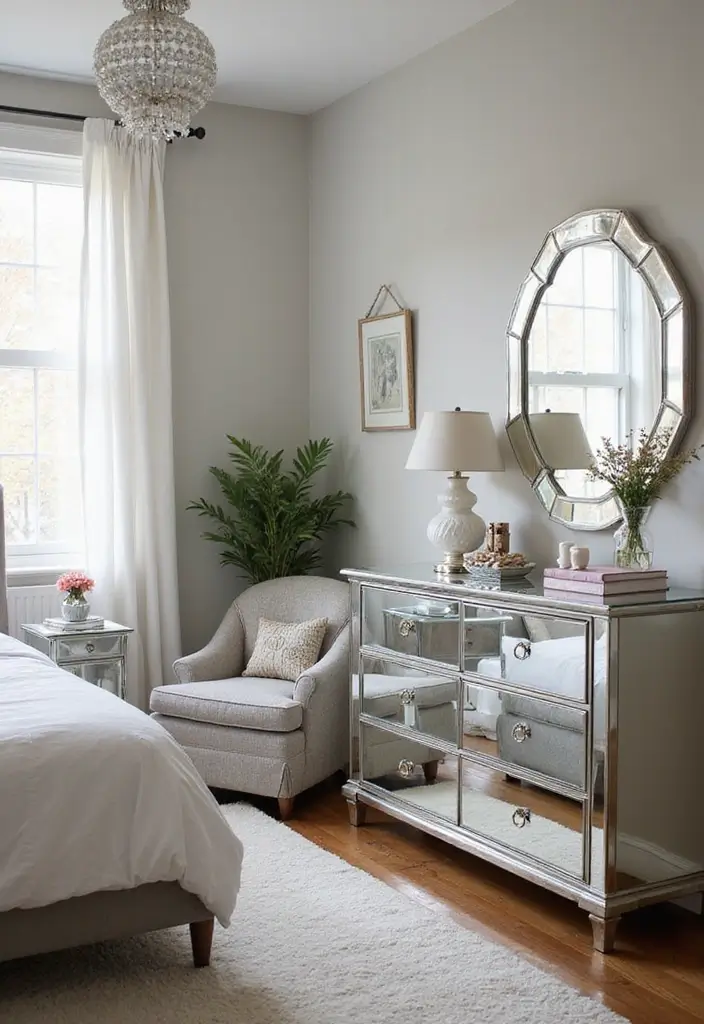
Are you trying to make a small bedroom feel bigger? You can do it with mirrored furniture. These pieces bounce light and keep the room feeling open. Here is why mirrors work in tight spaces.
– Reflect light to brighten the room
– Add depth and the illusion of extra space
– Bring a clean, glam touch without heavy weight
– Pair well with soft colors and simple textures
– Avoid dark tones that make the space feel cramped
Design tips:
– Use mirrored accents sparingly to keep the room airy
– Pick slim frames or frameless panels for a light look
– Balance with light fabrics and gentle patterns
– Place near a window or lamp to boost glow
Practical applications:
Try a mirrored dresser or a nightstand. A small panel on a headboard wall can also help reflect light. The goal is to double your brightness without doubling the clutter.
Care and maintenance:
Clean with a soft microfiber cloth. If needed, wipe with a light mix of water and mild soap, then dry right away. Avoid harsh cleaners that dull the glass.
Next steps: Ready to test it in your room? Start with a compact mirrored piece and watch your space feel airier. Measure your space and plan placement to keep traffic clear and the room calm.
7. Foldable or Extendable Tables
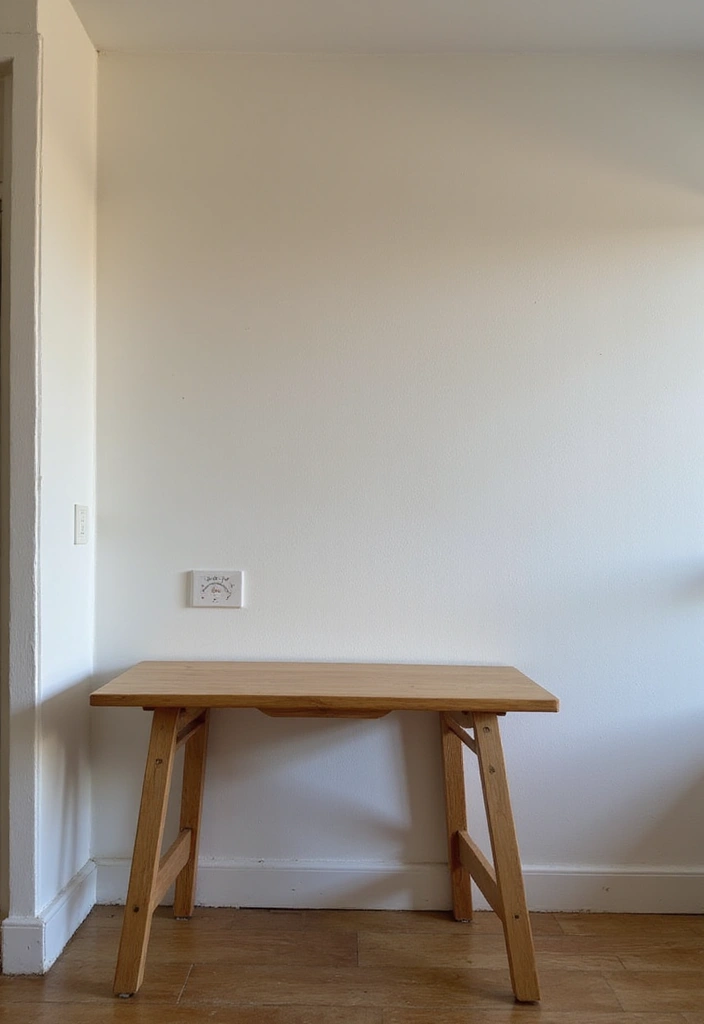
Stressed by a small bedroom? You can gain space with foldable or extendable tables. These pieces vanish when you do not need them and appear when you do. A folding table can tuck along a wall; an extendable desk grows to fit a project.
Here is how they help. You get a sturdy surface for work or meals without stealing floor space. You can lay out a map, then fold it away in seconds. You will feel calmer with less clutter around you.
Pro Tips:
– Pick designs that match your decor so the table blends in.
– Keep the tabletop clear when not in use to keep the room tidy.
– Test the fold or pull-out action. It should glide smoothly and stay steady.
– Choose a material that fits your style: wood adds warmth, metal looks sleek, laminates handle busy rooms.
– Think about height and footprint. A compact desk height works for study; a dining height fits meals.
This space saving option gives you comfort without crowding the room. You gain flexibility for daily life and small spaces.
Next steps: measure your space, check the wall clearance, and try a few models in person before you buy.
8. Colorful Accent Walls

If your small bedroom feels cramped, a splash of color can change the mood without crowding the room. A colorful accent wall draws the eye and gives you a sense of depth. It can make the space feel taller and more personal.
Here is why it works: you pick one wall to be bold, so the other walls stay calm. The contrast adds character without adding clutter. A softer finish keeps glare down and the room feeling cozy.
Design Tips:
– Pick the wall behind the bed as the focal point, so you wake up to color that sets the mood.
– Choose a color or wallpaper that fits your style. Dark tones create drama; light tones keep it airy.
– Go matte on larger walls to hide imperfections and keep the room calm.
– Use minimal art or mirrors on the other walls to balance the look.
Want more depth? Try a darker shade on one wall and lighter shades on the rest. You’ll see the room feel more spacious and layered, not busy. You can test ideas with swatches on different days and under natural light before you commit.
Next steps: gather swatches, buy a roll of wallpaper or a color chip, and plan a weekend project that fits your budget and skill level.
9. Use of Light Colors
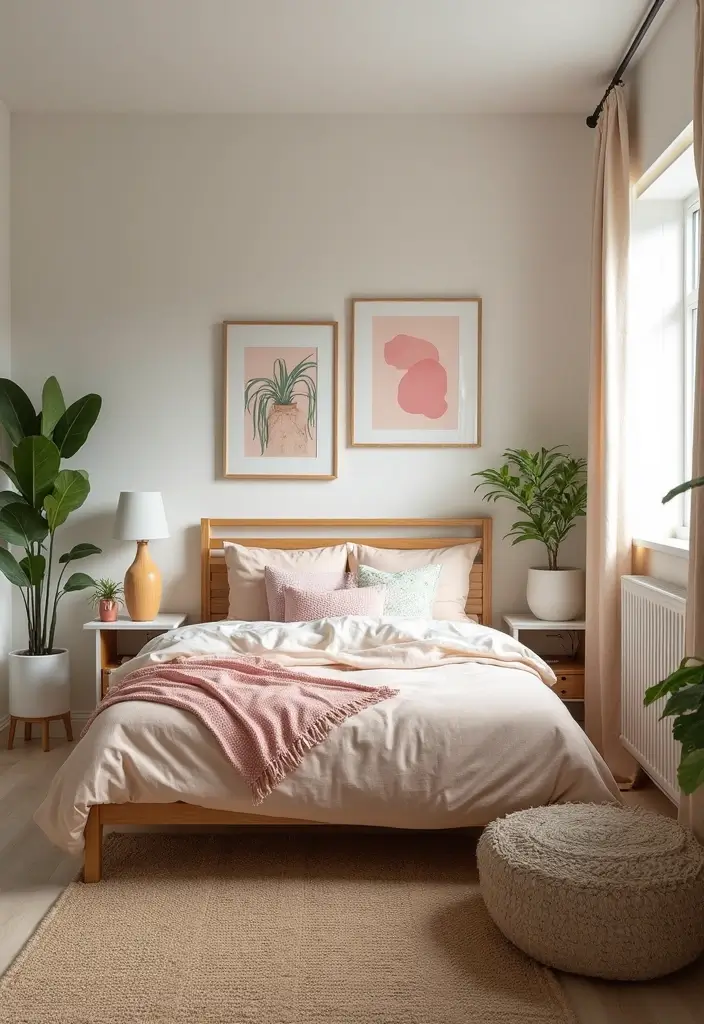
In a small bedroom, light colors can be your best ally. Here is why they work: they reflect daylight, cut shadows, and make the room feel wider. White, pale gray, and soft pastels keep the space calm from sunup to night. You’ll notice the room looks cleaner and feels easier to breathe.
Styling tips:
– Walls and ceiling: paint in soft white, eggshell gray, or a pastel wash to widen the space. Use matte finishes to keep glare low and the room feeling serene.
– Bedding: choose cotton or linen sheets in white or pale hues for a clean, cool feel. Add a light duvet in a breathable fabric.
– Furniture: mix light wood tones or white pieces to keep lines airy. Stick with simple shapes that don’t crowd the room.
– Accessories: add color with a few pillows, a throw, or a single vase. Limit the bold accents so the light color stays the star.
– Mirrors: place a slim frame opposite a window to double the light. Neutral frames work best in small spaces.
– Flooring: use a light rug, like pale wool or jute, to brighten underfoot. A larger rug helps the space feel open.
– Window treatments: sheer curtains let sunlight flood in without blocking heat or glare. Linen blends stay airy.
Next steps: keep most items in soft tones, and let color show up in small, purposeful accents. Light colors brighten the room and help you unwind after a long day.
10. Cozy Reading Nooks
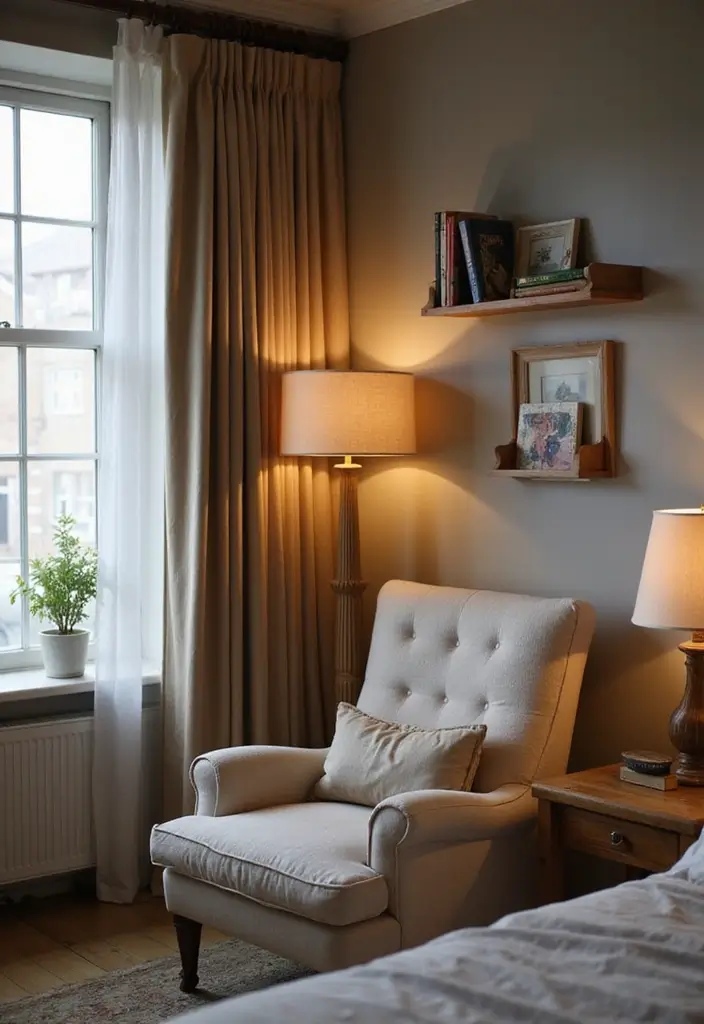
Need a calm spot in a small bedroom to read or unwind? A cozy reading nook gives you that space without crowding the room.
Start with a few essentials: a comfortable chair, a small side table, and soft lighting. Pick warm textures like a plush cushion, a fuzzy throw, and sturdy chair fabric. Keep colors light or earthy to feel open.
Place your nook near a window for natural light, or by a wall with a lamp for evenings. A gentle glow helps you read longer without strain. If you have a view, let it shine. If not, add a lamp that mimics daylight.
Ideas to Enhance Your Nook:
– Add a bookshelf or wall shelves within arm reach of the chair for quick reads.
– Use cushions and throws for comfort and color.
– Put down a small rug to anchor the space and soften footsteps.
Creating a reading nook makes a small bedroom feel like a quiet retreat. It gives you a personal corner to pause, think, and recharge.
Next steps: set up your space in minutes with these quick moves. Check it during the day and at night to see if the light feels right. Keep a small LED candle for mood, not heat. Enjoy this space.
Create your own cozy reading nook in a small bedroom—it’s the perfect retreat for relaxation! With just a comfy chair, soft lighting, and warm textures, you can escape into your favorite book in style.
11. Sliding Doors for Closets
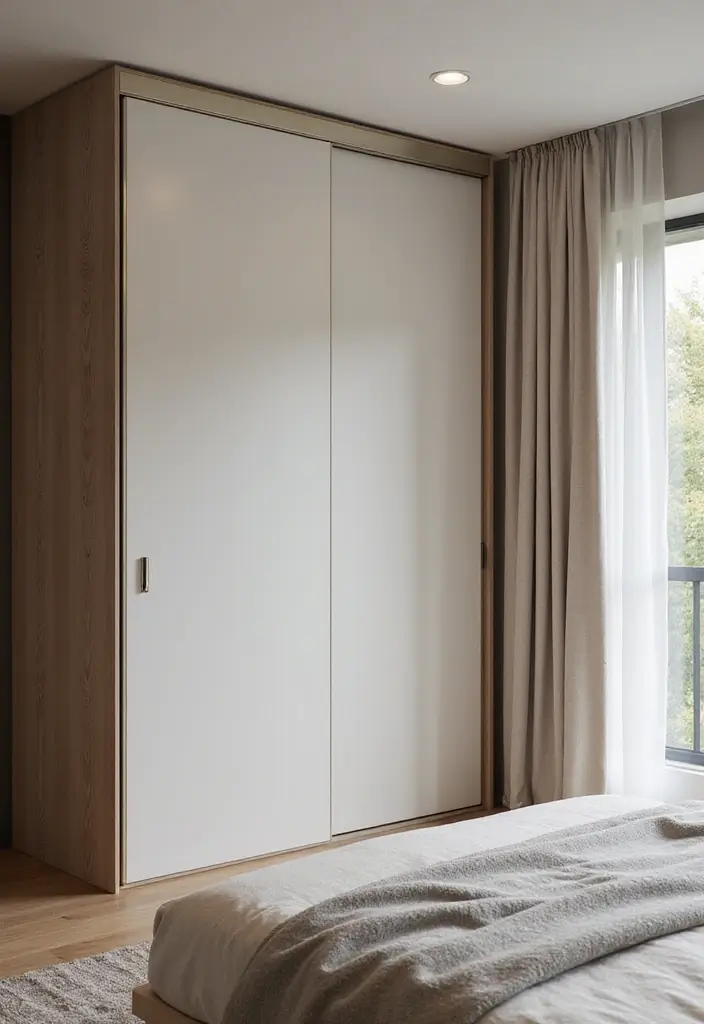
If your small bedroom feels tight, sliding closet doors can turn that around. They don’t need swing space, so you gain floor area for a desk, a chair, or a small bench. You move freely.
Here is why this change works. The closet stays visible as you walk by. You can place furniture closer to the wall without doors getting in the way.
Choose mirrored sliding doors to boost light. Mirrors bounce brightness from lamps and windows, making the room feel larger. If you want privacy, pick frosted glass or solid panels in a warm wood tone.
Finishes and styles for tight rooms:
– Mirrored panels for extra light
– Wood or patterned finishes for texture
– Frosted glass for clean privacy
Hardware and setup: Look for a recessed track for a clean line. Pick hardware that matches your bed frame, nightstands, and trim. If the doors are heavy, hire a pro to mount the track and panels.
Practical tips for daily use:
– Keep tracks clean with a soft brush
– Add soft-close hardware for quiet doors
– Use inside-the-closet shelves to keep items organized
Common questions: Do sliding doors save space? Yes, no swinging doors needed. Will they feel cheap? Not with sturdy tracks and a good finish.
Next steps: measure the opening, pick a finish, and choose a track style that fits your room.
12. Wall-Mounted Desks
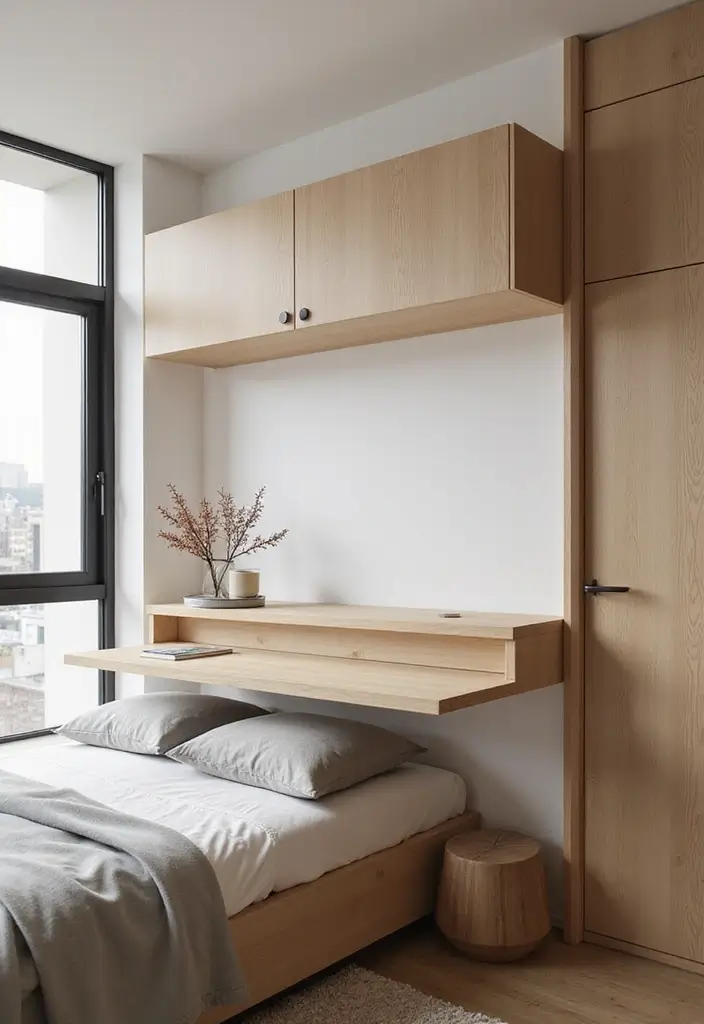
If you want a desk that fits a small bedroom, a wall-mounted option is your best ally. It folds away when you’re done, so your room keeps its open feel. No bulky furniture to trip over during the morning rush.
This setup works great in a bedroom that also serves as a workspace. Install shelves above the desk to hold chargers, notebooks, and spare cables. When the work day ends, you can close the desk and keep the sleeping area calm and clear.
What you gain: more floor space, easier cleaning under the desk, and a calm, uncluttered vibe. A wall-mounted desk is a true space-saving desk for small bedrooms. It blends with many styles and keeps your room flow intact.
Materials and styles
Choose a finish that matches your bed frame or vanity. Wood tops bring warmth, while a white or gray board keeps things airy. A slim metal frame makes the piece feel lighter. Consider a floating desk look if you want it to blend in.
Installation Tips:
– Find sturdy anchors and mount into wall studs when possible.
– Use a level to keep the desk straight.
– Test the weight you plan to put on it before you finish.
– Add a compact chair and a small lamp to complete the setup.
– Run cords neatly with a slim cable sleeve or clips.
Next steps
Measure your space, pick a height that puts your elbow at a comfortable level, and choose a model with a shelf above. With the right wall-mounted desk, your small bedroom becomes a smart, comfortable work corner.
13. Bedside Carts

If your bedroom feels crowded, a bedside cart can be a smart swap for a bulky nightstand. These small, movable tables sit close to you and hold the things you reach for at night. A cart on wheels lets you roll it to a new spot in seconds. If you prefer a steadier look, choose a solid base and a sleek profile.
Why bedside carts work in tight rooms
– They come in different heights and widths to fit small spaces.
– Wheels make reconfiguring your space simple.
– Multiple shelves help you store books, chargers, and a plant without a mess.
– Finishes range from warm wood to cool metal, so you can match your decor.
What to look for
– Pick a color that blends with your room and bed frame.
– Choose a material you like, such as wood, metal, or a glass-tinish surface.
– Check the height so the top shelf aligns with your bed height.
– Decide if you want wheels for mobility or a stationary base for a clean line.
– Add a small basket or bin on the lower shelf for extra storage.
Practical uses
Top shelf can hold a lamp and a phone. Mid shelf fits a book or notebook. The bottom shelf is great for a charger, tissues, or a tiny plant. Keep the look simple to avoid clutter.
Placement tips
Place the cart on your bed side where you sit most often. If two people use the bed, consider a cart on each side. Don’t overload the shelves to keep the cart stable.
With the right bedside cart, your small bedroom gains function and style without feeling crowded.
14. Smart Use of Textiles
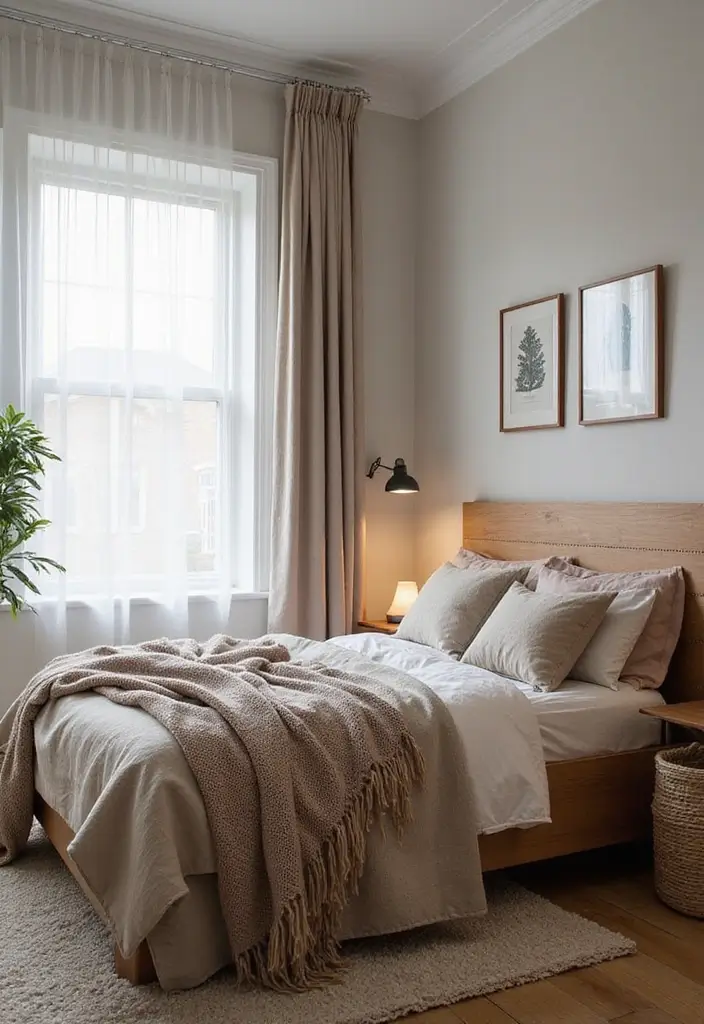
If your small bedroom feels tight, textiles can help you breathe room into it. They add warmth and personality without crowding the floor. Layered throws, cushions, and a rug can make the space feel bigger and cozier at the same time.
– Layer with light fabrics
Use a soft throw over the end of the bed, a few cushions on the chair, and a low-pile rug near the bed. These pieces bring color and texture without weighing the room down. Pick lightweight fabrics that move easily and wash well.
– Define zones with texture
Textiles can carve out small corners. Put a rug under a comfy chair to create a reading nook. Add a slim curtain near a desk to soften the workspace. The eye sees clear zones, even in a tight footprint.
– Texture and color tips
Choose fabrics that fit your color plan. Mix textures like cotton, linen, and knit to catch light from different angles. Keep patterns small and pair them with solid colors to avoid a busy look.
– Practical examples you can try
Bed idea: white duvet, a knit gray throw, linen pillows. Corner idea: natural-fiber rug, a soft chair, a warm lamp. Desk idea: a light curtain, a slim mat, and a calm fabric chair cushion.
– Care and limits
Favor fabrics that are easy to clean. Keep a few key pieces and rotate them seasonally. This keeps the room feeling fresh without overdoing it.
Next steps: pick a couple of textiles you love, place them in the room, and live with the feel for a day. Adjust as needed to keep the space airy and inviting.
Textiles are your best friend in small spaces! A few layered throws and cushions can turn a cramped room into a cozy retreat, adding style without the clutter. Embrace the warmth and watch your bedroom ideas for small spaces come to life!
15. Creative Lighting Solutions
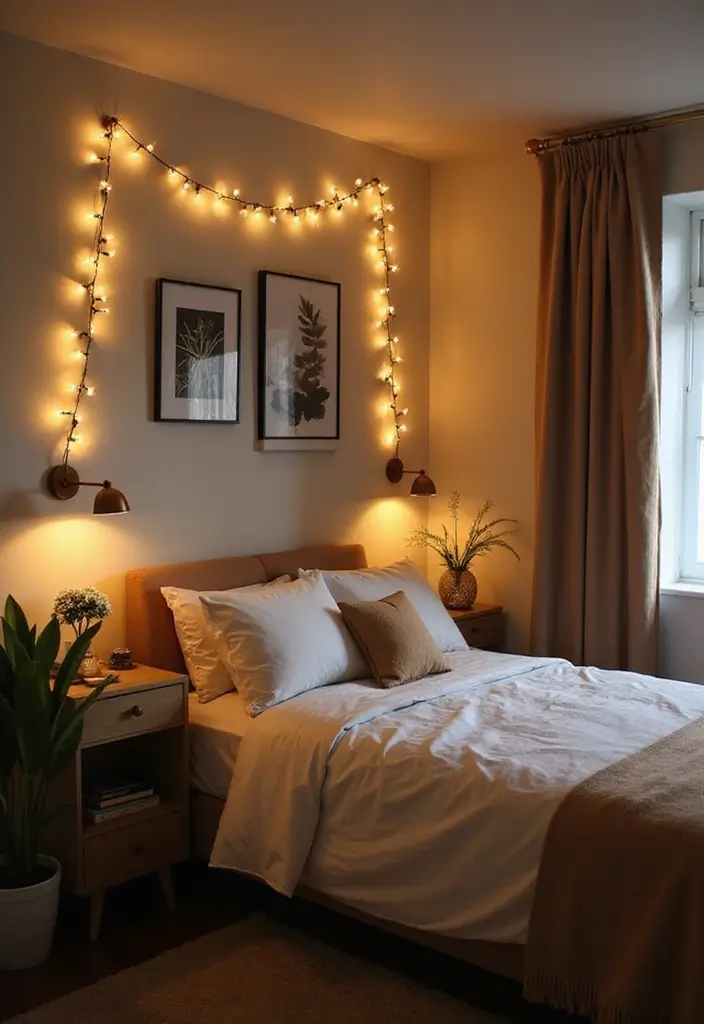
Here is why lighting matters in a small bedroom. It makes the room feel bigger and easier to use. It also changes mood fast.
Here is a simple plan you can follow.
Lighting Ideas:
– Use wall sconces or hanging pendant lights on opposite walls. This frees up table space.
– Pick dimmable fixtures. You control brightness for bright mornings or cozy nights.
– Add LED strip lights along shelves or under a bed ledge. The result is a clean, modern line of light.
– Pair overhead lighting with a task light. A small ceiling light plus a reading lamp works well.
– Go warm. 2700K to 3000K feels comfy. For tasks, use 3500K to 4000K.
– If ceiling height is tight, choose a compact flush-mount. It keeps lines clean.
– For color, pick warm bulbs around 2700K to 3000K. If you want a mood boost, add a string light with a soft amber glow.
Here is a quick tip: string lights can soften the room. Place them behind the headboard or around a mirror for a gentle glow.
What to do next: pick one idea to start this week and see how it changes how you use the space. Add a second layer if you want more glow.
Great lighting is the secret ingredient that transforms small bedroom ideas into stylish sanctuaries. Illuminate your space, set the mood, and watch your small room feel like a cozy retreat!
16. Room Dividers for Zones

In a small bedroom, you want spaces that serve real tasks. A room divider helps you carve out a sleeping zone and a workspace without closing in the room.
It acts like a light wall. It stays put when you want a quiet corner, and it can move when you change the layout. The right divider adds texture and a sense of order.
What works well
– Curtain divider: a light fabric drapes softly. It lets sun spill in and you can pull it closed for privacy.
– Bookshelf divider: shelves hold books, photos, or a plant. It creates a clear line between bed and desk.
– Decorative screen: a wood or metal panel with a pattern. It brings style and a touch of character.
– Folding screen: portable and easy to reposition. It gives you flexible zones for guests or work.
– Tall plants: a couple of large pots form a living barrier. They soften the edge and bring natural scent.
Pro Tips:
– Pick light options you can move or adjust.
– Match the divider to your room’s color and style.
Next steps: test one divider for a week. See how it feels when you open drawers and walk around. If it helps, keep it. If not, try a different type. A well-chosen divider makes a small bedroom feel calmer and more useful.
17. Plants for Freshness
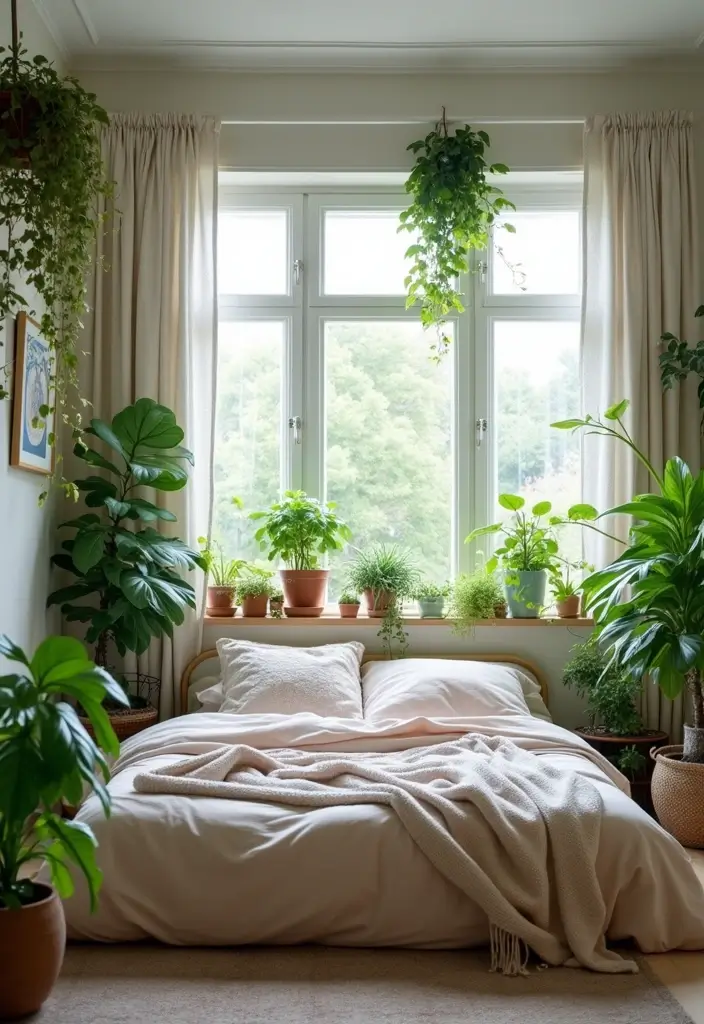
If you want your small bedroom to feel alive without crowding it, add plants. They bring fresh color, a soft texture, and a calm vibe you can feel.
Here is why plants fit a tight space. They sit on shelves or hang from the ceiling, not on the floor. They don’t crowd you, yet they brighten every corner. They also make the air feel cleaner, which helps you breathe easier at night.
Let’s break it down. Pick plants that are easy to care for and can handle dim light. Good choices include snake plants, pothos, ZZ plants, and spider plants. They stay healthy with simple care and won’t demand your full attention.
Hanging and wall setups save floor space big time. Use wall planters, a narrow shelf with a few pots, or a ceiling hook for a trailing plant. Small ferns or pothos look great draped over a high shelf. A tall plant in a corner adds height and balance.
Plant Tips:
– Use planters that match your room style.
– Put plants near windows so they get light without glare.
– Water when the soil is dry; avoid overwatering.
Next steps: start with two easy plants, then add one hanging or wall option. Watch how the room feels more open and welcoming.
18. Use of Decorative Trays
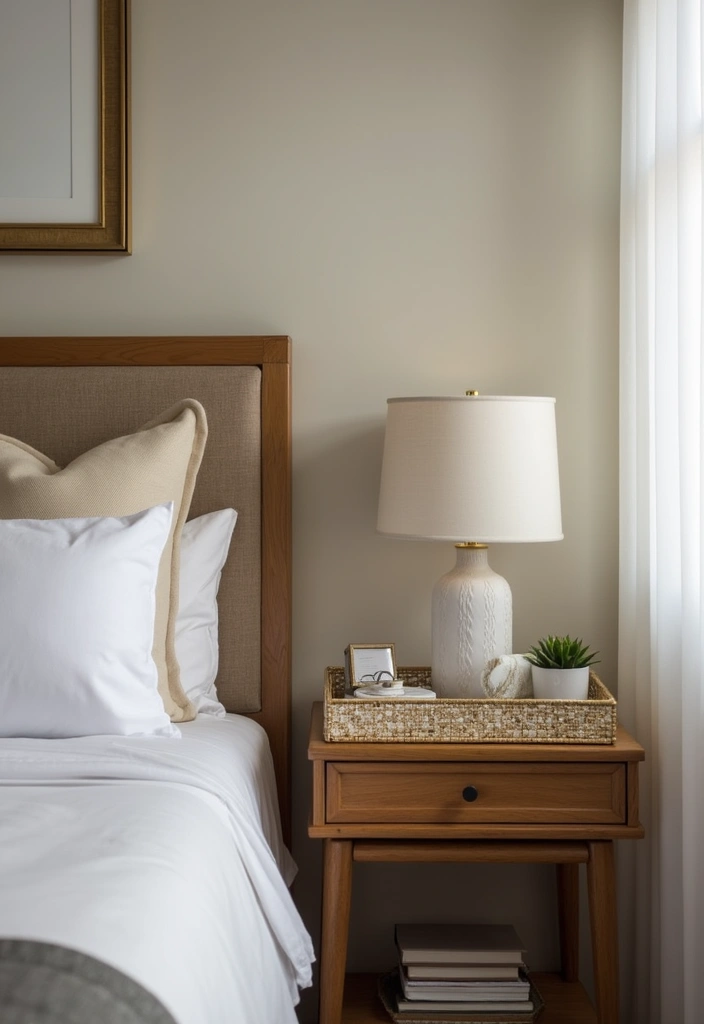
Is your small bedroom busy with little things on every surface? A decorative tray can bring calm and order in a single move. It gathers jewelry, watches, a tiny plant, and a glass of water in one neat spot. You see less clutter, and your nightstand or dresser looks more put together. A tray also protects finishes from scratches and spills. Pick a piece that fits your room’s color and vibe so it feels built in, not an afterthought.
Here is why trays work well in tight spaces. They create a clear zone on a nightstand or dresser. They give you a simple place for items you reach every night, so you keep the top clean longer. Trays come in many styles, from warm wood to cool ceramic. Choose a size you can lift with one hand.
Practical Tips:
– Look for trays with small compartments to keep rings, earrings, and clips in place.
– Use a tray as a base for a short stacking setup with a couple of books and a candle.
Next steps: try a tray that contrasts with your furniture for a pop, or one that matches your bedding for a cohesive look. With one well-chosen tray, you gain space and add a touch of style you can see and touch every day.
19. Utilize the Ceiling
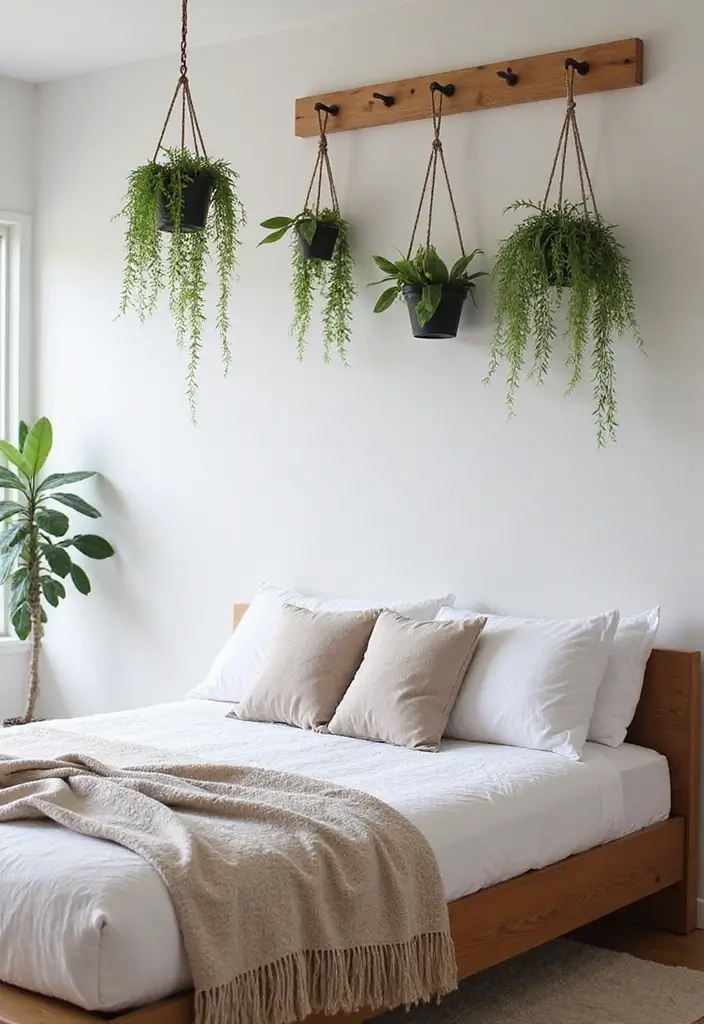
If your small bedroom feels cramped, look up. The ceiling is part of the space, not just a top edge. Hooks up high let you hang decor, tiny plants, or even a hammock chair for a moment of calm. Hanging items there creates visual interest and frees floor space. Using the ceiling draws the eye upward, making the room look taller. For a cozy touch, add soft fabrics or warm string lights.
Ideas for ceiling use:
– Install a hanging chair to create a cozy reading nook.
– Use decorative hooks to hang plants or art pieces.
– Add soft fabric or string lights for a warm glow.
Safety first matters, so use solid anchors and keep cords tidy.
Measure clearance above the bed to avoid bumps.
Always plan room for movement.
To finish, remember that small changes up high can change how you feel down low. Choose sturdy materials and simple, breathable colors to keep the space calm. By focusing on ceiling details, you add character without crowding the floor. The right setup can make your room feel bigger, brighter, and more inviting while staying easy to live in.
20. Minimalist Decor
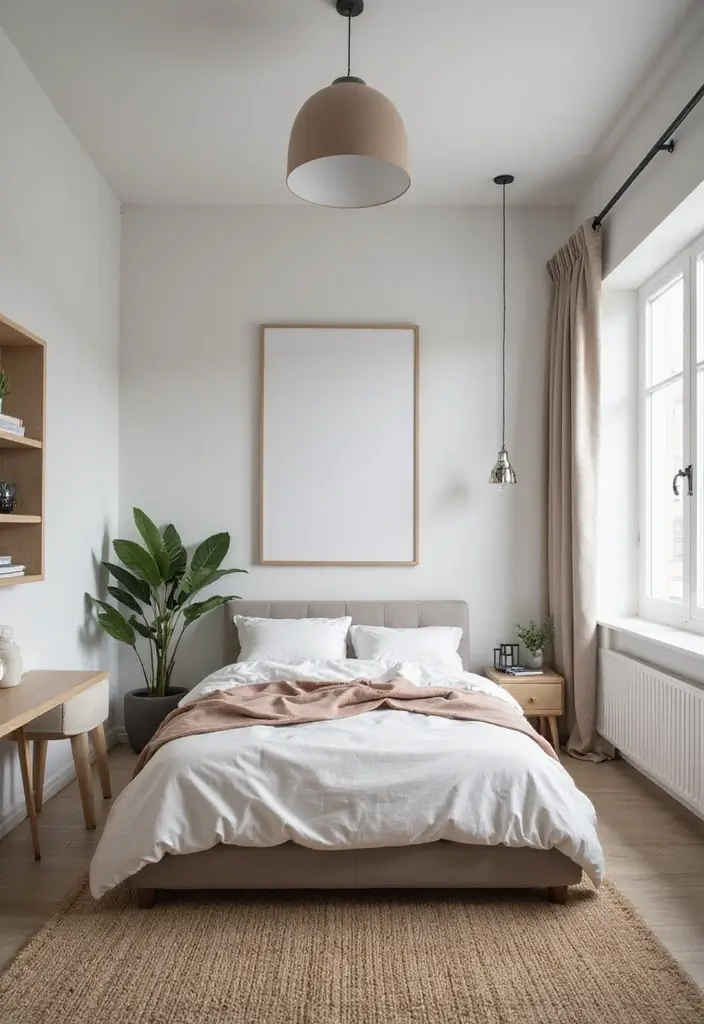
If your small bedroom feels crowded, a minimalist style can give you space to breathe. It trims clutter and makes every inch feel open. You will see more air, more light, and you will sleep easier.
Here is why it works: fewer pieces mean less dust, easier cleaning, and a calm vibe that helps you wind down. You can still have life in the room with a few careful choices.
Let’s break it down.
Minimalist Tips:
– Pick a set of high quality pieces. A slim bed frame, a tidy nightstand, and a wall shelf may be enough.
– Use a neutral base. Think warm whites, soft grays, or sand tones. Add one bold accent color in a throw or pillow.
– Keep surfaces clear. Put items in drawers or baskets. Let the walls and floors breathe.
– Choose meaningful decor only. A single framed photo or a favorite textile can carry meaning.
– Focus on texture. Weave in natural materials like wood, linen, and cotton to add warmth without clutter.
Next steps: set a 20 minute declutter timer, store extras in a bin, and refresh with one small swap per season.
A minimalist room feels like a quiet retreat you can create in a weekend.
A minimalist bedroom isn’t just about fewer items; it’s about creating a serene space where you can truly rest. Embrace simplicity, and watch how it transforms your small space into a haven of calm.
21. Smart Use of Area Rugs

Small bedrooms can feel cramped.
A smart rug plan changes that.
Rugs add warmth, texture, and personality.
Here is why rugs matter in tight spaces.
They define zones and guide your eye.
Go big to anchor the bed.
A large area rug under the bed with edges that spill out makes the room feel longer.
If that feels bold, try two smaller rugs to mark zones, like a reading nook or a desk.
Choose colors and patterns that fit your decor and keep the room calm.
Rug Tips:
– The rug should be proportional to the furniture around it.
– Layer rugs for depth and style.
– Choose durable materials for high traffic, like wool or poly blends.
– Think about power cords and rug padding to keep it in place.
Smart use of area rugs adds comfort and allows you to express style without crowding the space.
A rug should invite your feet to slow down.
Next steps: measure the room and plan bed and seating, then test rug sizes with tape.
Move the rug around until you love the flow.
Choose a rug you can clean easily and fits your budget.
Take a note of what works and repeat it.
You can reuse this idea later.
22. Creative Wall Art
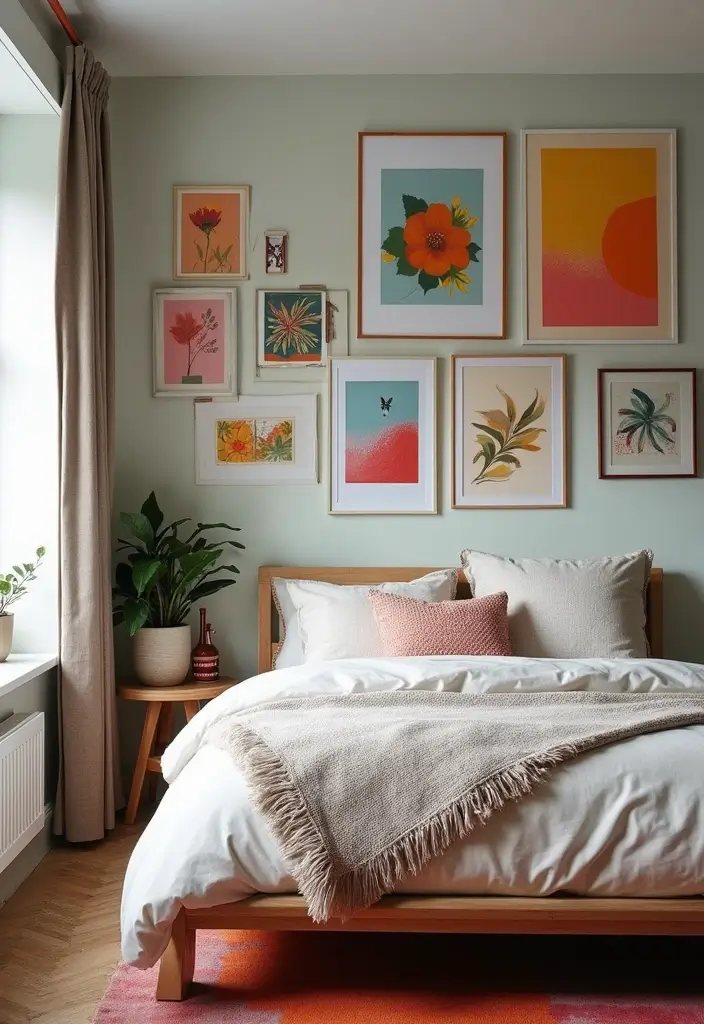
Your small bedroom can still feel stylish. Creative wall art lets you tell your story without touching the floor. A gallery wall in a small bedroom ties the look together. It draws the eye up, adds texture, and makes the space feel bigger.
Here is how to build it:
– Pick a wall you notice first when you enter or when you lie in bed.
– Plan a grid or a loose splash layout. Use paper templates or painter’s tape to test before you commit.
– Mix different materials: wood frames, metal frames, canvases, and a textile piece.
– Use a simple color palette to tie pieces together.
– Mount at eye level. Leave space around each piece so the wall doesn’t feel crowded.
Next, a few practical tips:
Tips for Wall Art:
– Choose art that shows your interests.
– Mix shapes and sizes for a varied look.
– Add a textile wall hanging or small rug for cozy texture.
– Keep frames light and consistent for a clean vibe.
– If space is tight, lean a single statement piece on a shelf or dresser.
Creative wall art lets you customize your space, adds texture, and keeps your floor free for movement.
23. Stylish Curtains
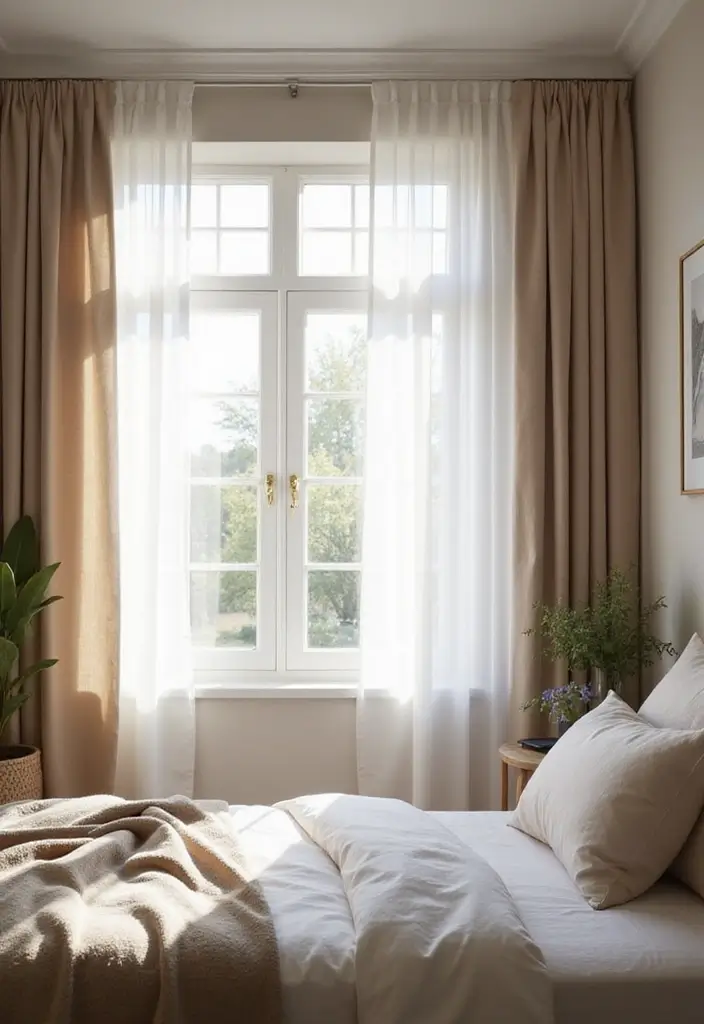
Small bedrooms can feel tight. The right curtains change that. They guide light, add color, and lift the ceiling visually.
Here is why curtains matter in small rooms
– Light fabrics: Choose cotton voile, linen blends, or sheer fabrics. They filter daylight and keep privacy intact.
– Ceiling-height illusion: Install the rod close to the ceiling for a floor-to-ceiling look, and let panels skim the floor. This makes the space feel taller.
– Neutral tones: Whites, creams, and soft grays create a calm, airy vibe. They pair easily with furniture and decor.
– Patterns in small doses: Tiny stripes or subtle dots add depth without weighing the room down.
– Layer with sheer panels: Combine a lightweight sheer with a thinner blackout or shade. You get bright mornings and private evenings.
– Extend beyond the frame: Let curtains extend 8 to 12 inches past the window on both sides. It widens the view and hides wall clutter.
– Easy care and setup: Pick machine-wash fabrics. Use a simple rod or removable brackets if you move or reconfigure often.
Next steps
Measure your windows, choose a light fabric, and mount the rod. Start with one window to test the feel. With these moves, your small bedroom will look brighter and more put together.
24. Personalized Decor Items
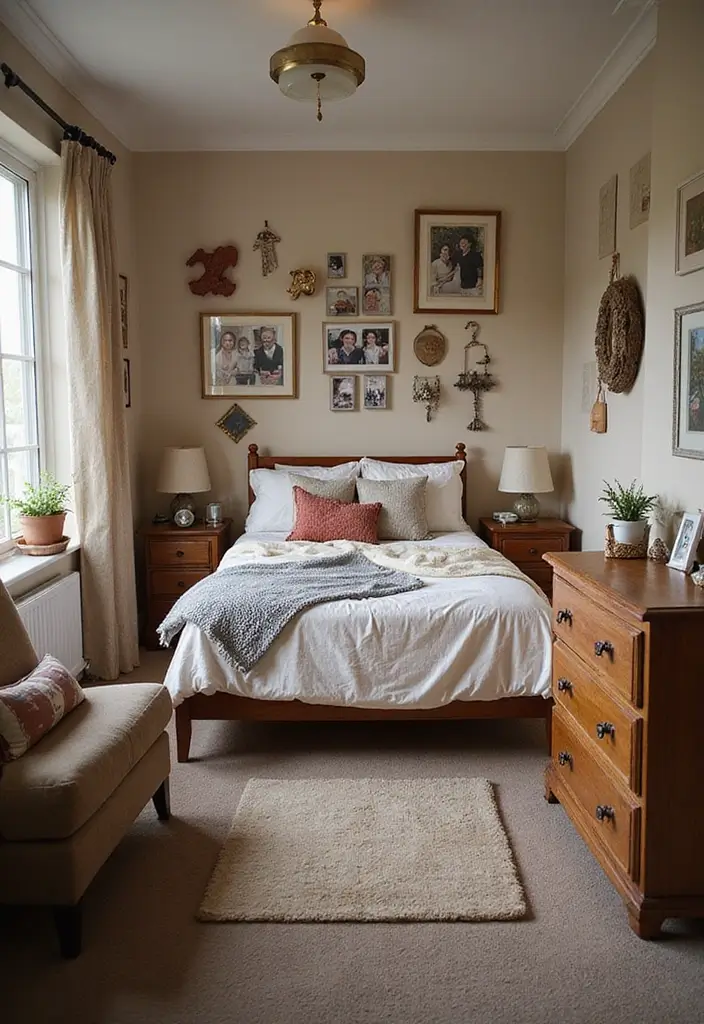
Are you trying to keep a small bedroom feeling like you and not cluttered? Personalize your space with decor items that share your story. Pick pieces you truly love—handmade crafts, family photos, or keepsakes from trips. These items bring warmth and make the room feel like home.
Display Tips
– Choose 3 to 5 meaningful pieces. Too much can feel busy.
– Pick frames and displays that match your room style.
Want ideas on where to place them? Shelves, a corner wall, or a gallery wall above the bed work well. A simple row of framed photos on a narrow shelf keeps sightlines clean. A corkboard or a small fabric-covered pin board adds texture and a place to swap in new memories. If you travel, use a few souvenirs in a shallow flat display case to avoid bulk.
Materials matter. Wood frames in a light tone feel calm on white or pale walls. Black metal frames give a modern touch. Glass fronts protect photos from dust.
Choosing items with color tied to your scheme helps. A single color in frames or mats creates a cohesive look. You can rotate items by season to keep the space fresh without adding clutter.
Next steps: scan your space, pick 3 to 5 items, and plan one easy wall spot or shelf for them.
25. Maximize Natural Light
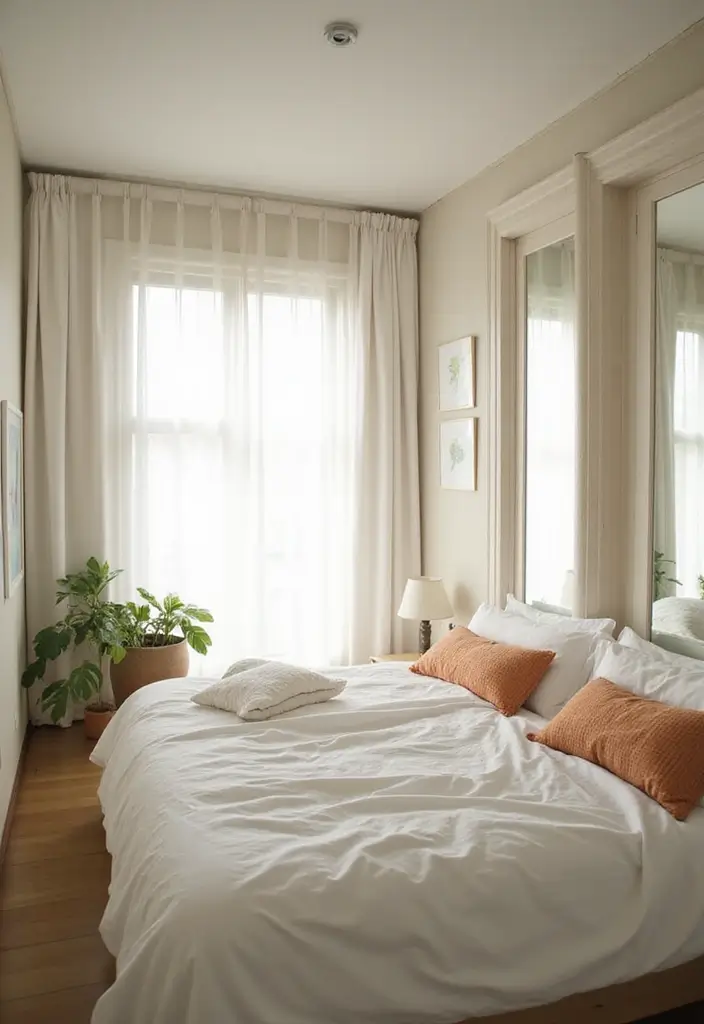
Are you trying to wake up a small bedroom with more daylight? The right light can make the room feel bigger, calmer, and more inviting. You can bring in sunshine without a big remodel. Here is how to boost daytime brightness and keep your space cozy.
Tips for letting in daylight:
– Choose translucent curtains that diffuse light without blocking the view.
– Put mirrors where they catch and bounce sunlight across the room.
– Keep window sills clear so nothing blocks the glow.
– Pick a light color palette—soft whites, pale grays, warm beige—to reflect more light.
– Opt for furniture with clean lines and low profiles near windows to avoid shadowy corners.
If your windows are shaded or face away from the sun, don’t worry. You can still brighten the space with smart choices.
Next steps: Use glossy surfaces and light LED bulbs to mimic daylight when the sun hides. A glass-topped nightstand or a chrome lamp can help spread light further.
By reflecting daylight with mirrors and choosing the right fabrics, you can give a small bedroom a brighter, more open feel. You will notice the difference during morning routines and evening wind downs.
Let’s break it down: start with curtains, then map out a mirror plan, test colors, and finally arrange your furniture. A few tweaks can lift the mood and make the room feel larger without adding square footage.
26. Utilize Corners Effectively

Your small bedroom can feel tight. Corner space can help.
Here is why corners matter in a tiny room: they add storage without stealing floor space. They create cozy zones you can use for work, reading, or quiet time.
Let’s break it down with ideas you can try this weekend.
Corner Tips:
– Use L-shaped furniture to fit in the corner and keep a clear path.
– Keep decor minimal to prevent clutter.
– Corner shelves for books or plants add height and charm without crowding you.
– A small reading nook with a comfy chair and a soft throw makes a daytime escape.
– A slim corner desk hugs the wall, leaving room for a chair and a lamp.
– A tall plant or slim floor lamp adds life and gentle glow.
– A wall cabinet or floating cubbies hold odds and ends out of sight.
Here is how to pick what fits best. Measure the depth of nearby furniture, then plan for at least a few inches of walk space. Choose pieces that mount to the wall or sit flat against the corner. Pick light colors or natural woods to keep the room feeling open. Soft lighting, like a warm bulb in a small shade, makes the corner feel inviting.
Next steps: start with one corner. Add a shelf or a chair first. See how it changes your room in a week.
27. Use of Bold Patterns
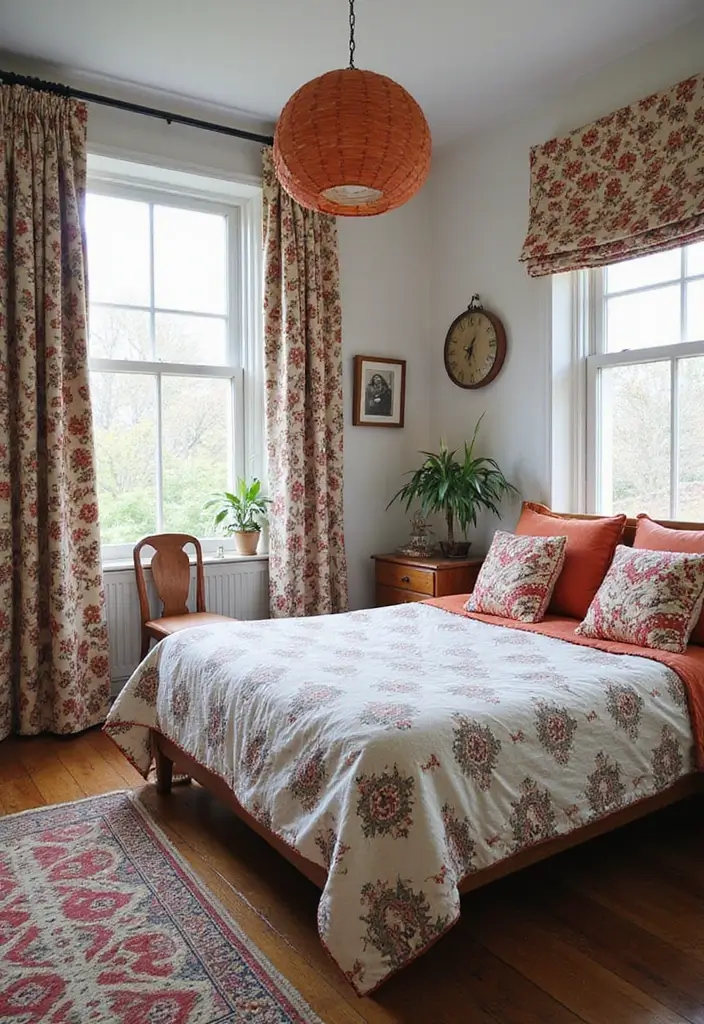
Your small bedroom can shine with bold patterns when you plan them well. Patterns add depth and character without making the room feel crowded. Use one or two patterned pieces to create a focal point, then balance them with solid colors.
Here is how to make it work:
– Pick one main pattern for a duvet cover or an area rug to anchor the space.
– Add a second, smaller pattern in pillows or a window treatment.
– Keep walls and major furniture in solid colors to let the patterns stand out.
Styling Tips:
– Use patterns in moderation to keep a clean look.
– Mix patterns in colors that belong to the same family for a cohesive, stylish feel.
Why this approach helps in a tight room: bold patterns draw the eye to a specific spot, so you notice depth rather than the lack of space. A simple color frame around your pattern makes the room feel organized and calm.
Next steps: choose your palette, gather 2 patterns that fit, and test their scale in a sample swatch before buying. Small rooms benefit from tone changes, not busy chaos.
Choose breathable fabrics like cotton or linen for comfort and easy care. Texture adds depth for everyday use.
28. Space-Saving Headboards
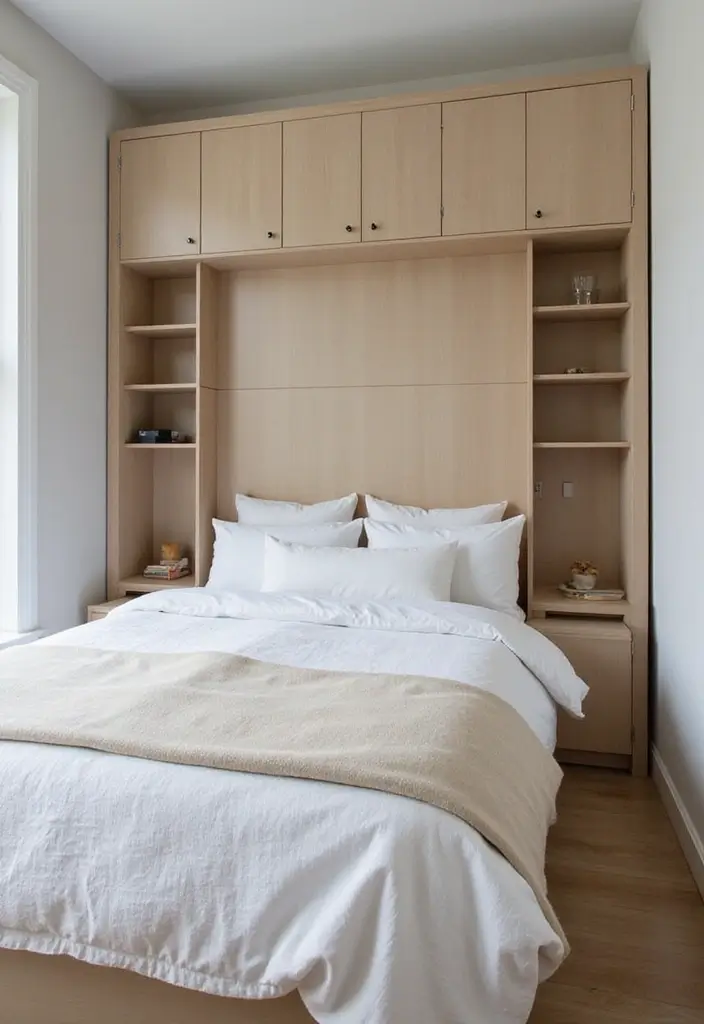
If your bedroom is small, you need smart ideas. A headboard with built-in storage can be that fix. It keeps essentials close to you and clears surface clutter.
Here is why it helps: you save space, cut the number of pieces on the floor, and create a neat look. You can reach a book, a clock, or a charger in one place, even at night.
Headboard ideas:
– Upholstered with shelves built into the sides for a soft touch and handy spots.
– Wood or metal frames with cubbies for books and glasses.
– A tall panel with slim ledges that hold a lamp and a few essentials.
What to look for
– Built-in shelves or compartments that fit your needs.
– Sturdy mounting that matches your bed width and mattress height.
– Depth that stays out of the way but holds what you use every day.
Styles and tips
– Pick materials that match your room: warm wood, cool metal, or a comfy fabric.
– Add a small LED strip along the edge for easy night light.
– Check price and weight. Make sure it can be attached safely.
Next steps. Measure your bed, pick a style, and list the items you want nearby. A well chosen headboard can add charm and function without crowding the room.
29. Chic Canopy Beds
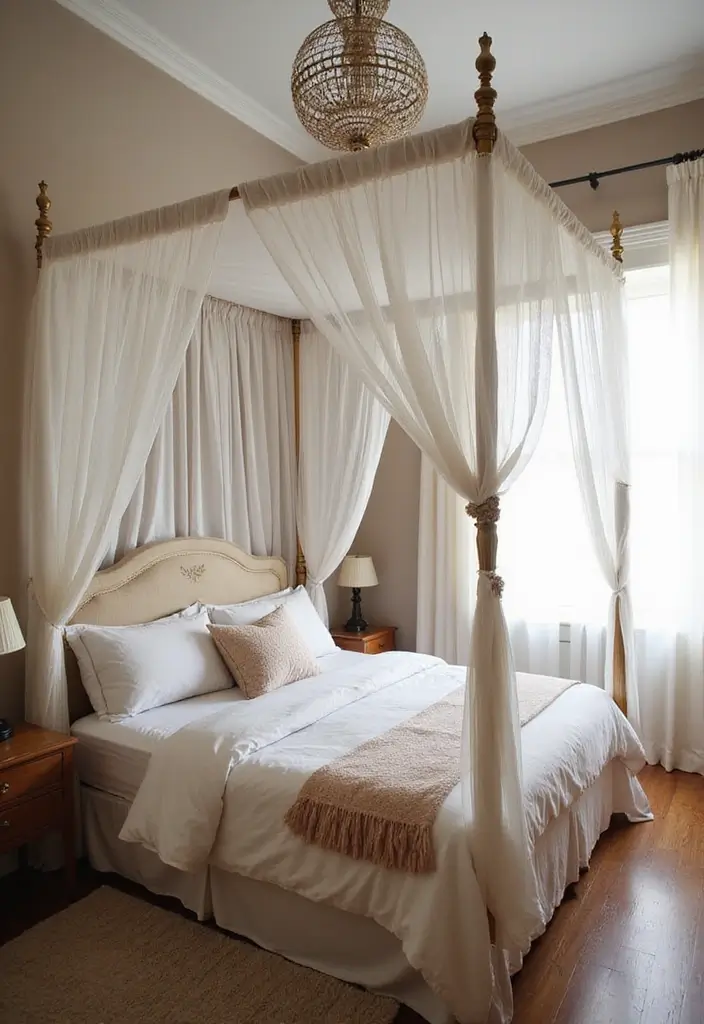
You want a touch of luxury in a small bedroom. A chic canopy bed can give that grown‑up feel without taking over the room. Sheer fabric adds height and privacy. It lets light in, so the space still feels open.
Here is why a canopy helps in small spaces. It creates a focal point above your bed. The fabric softens the area and draws the eye upward. You get a cozy sleep zone without extra furniture.
Canopy Ideas:
– Choose a simple rod that matches your decor style.
– Use fairy lights to add a soft glow inside the canopy.
A canopy is easy to install and easy to remove if you move. You can DIY it with a lightweight curtain rod and sheer fabric. Pick fabrics like cotton voile, chiffon, or light linen. White, ivory, or soft gray keeps the room bright and airy.
Next steps to try at home. Measure your bed so the canopy height feels balanced, not crowded. If you’re renting, use a tension rod and removable hooks to avoid wall damage. Mount the rod to the ceiling or walls with sturdy brackets if you want a more permanent setup.
Care and customization ideas. Choose washable fabrics for simple cleaning. Add a second, thinner layer for a subtle, layered look. If you sleep late, consider a light blackout liner inside the canopy for better rest.
Common questions you may have. Will a canopy make a small room look cramped? Not if you keep the fabric light and the lines clean. It creates a taller feel without adding bulk.
Try this gentle, stylish upgrade and watch your small bedroom feel special without losing floor space.
30. Embrace a Theme

Here is a plan to give a small bedroom a single, steady look. A clear theme cuts clutter and makes every piece fit.
First, pick a mood you can live with. Calm and simple or cozy and warm work well. Let that mood guide colors and textures. Here is why: colors set the tone, fabrics add warmth, finishes tie items together. Next, build a tiny kit of anchors. Choose three pieces that show your theme—bedspread, rug, wall art. Make them share color or texture so they feel related.
Then set a color palette. Use one main color, a soft secondary, and one accent. Keep walls light so the room looks bigger. Next, pick materials that echo each other—wood, metal, cotton, linen. That consistency makes the space feel finished.
Theme ideas:
– Boho: earthy tones, woven textures, plants
– Minimalist: clean lines, neutral shades, simple silhouettes
Tips: test swatches on the wall, collect small fabric samples, and swap items later if needed. Use lighting to reinforce the theme—warm lamps for cozy vibes, white lamps for a crisp look. With a little planning, your small bedroom will feel intentional and well put together. Next steps: start with three anchor pieces and build from there.
Conclusion
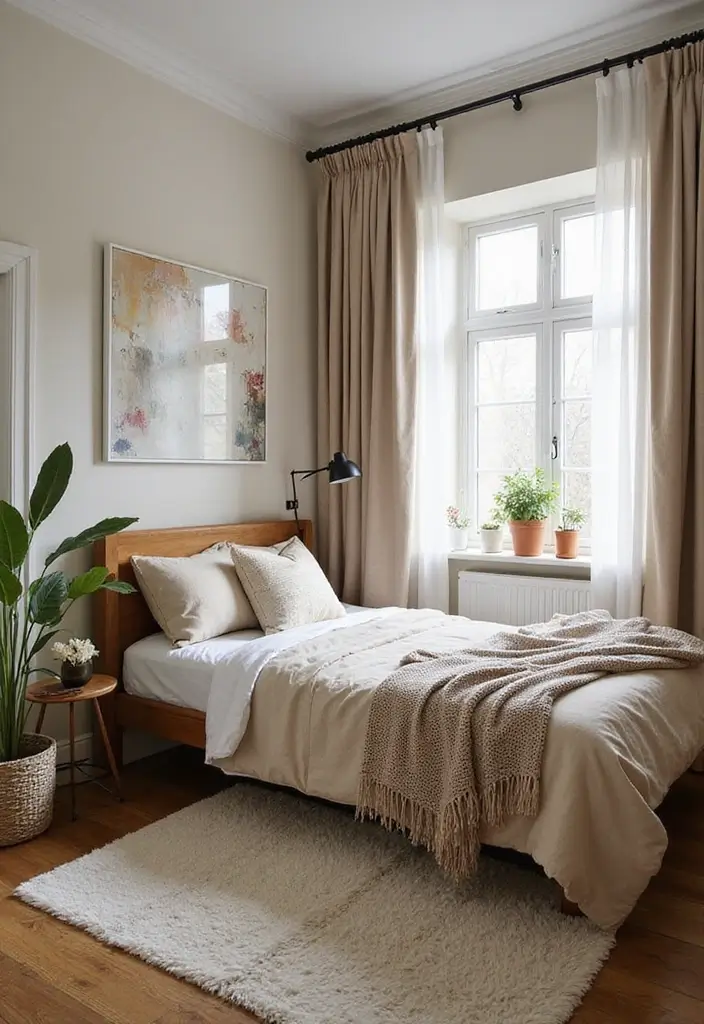
Designing a small bedroom can be a rewarding adventure that challenges you to think creatively.
With the right strategies and innovative solutions, you can turn even the tiniest spaces into functional and stylish havens. From multi-functional furniture to smart organization tips, the possibilities are endless!
So, which idea inspired you the most? Let your creativity flow and make the most of your cozy space!
Frequently Asked Questions
What are some effective small bedroom decor ideas that maximize space?
Maximizing space in a small bedroom can be a fun challenge! Consider using multi-functional furniture, like a bed with built-in storage or a wall-mounted desk that folds away when not in use.
Incorporate vertical shelving to utilize wall space, and opt for light colors to create an illusion of a larger area. Don’t forget to add personalized decor items to keep your space feeling cozy and unique!
How can I create a cozy reading nook in my small bedroom?
Creating a cozy reading nook in a small bedroom is all about smart furniture choices! Start with a comfortable chair that fits your style, and add a small side table to hold your books and a cup of tea. Use textiles like layered throws and cushions to make it inviting.
Position your nook near a window to take advantage of natural light and consider adding a small plant for a fresh touch!
What are some organization tips for small rooms?
Keeping a small room organized is key to maintaining a calm atmosphere. Use under-bed storage for seasonal items, and opt for decorative trays to corral smaller items on surfaces.
Consider built-in wardrobes that utilize vertical space and sliding doors to save room. Regularly declutter to keep only what you truly love and need, making your space feel more open and serene.
How can I make my small bedroom feel bigger with lighting?
Lighting plays a crucial role in making a small bedroom feel more spacious! Use creative lighting solutions such as wall sconces or floor lamps that brighten the corners of the room.
Incorporate mirrors to reflect light and create depth. Soft, warm lighting can also enhance the cozy atmosphere while making the space feel inviting and open!
Are there space-saving furniture options that look stylish?
Absolutely! Stylish space-saving furniture can be both functional and chic. Look for furniture with built-in storage, like a stylish headboard with shelves or a chic canopy bed that adds height without overwhelming the space.
Foldable or extendable tables can also be great options, allowing you to maximize your room’s use while maintaining a stylish aesthetic. Don’t be afraid to mix and match textures and colors for added flair!
Related Topics
small bedroom decor
space-saving furniture
minimalist design
organization tips
stylish storage
multi-functional furniture
creative lighting
budget-friendly solutions
room dividers
easy bedroom hacks
modern decor
cozy reading nook

